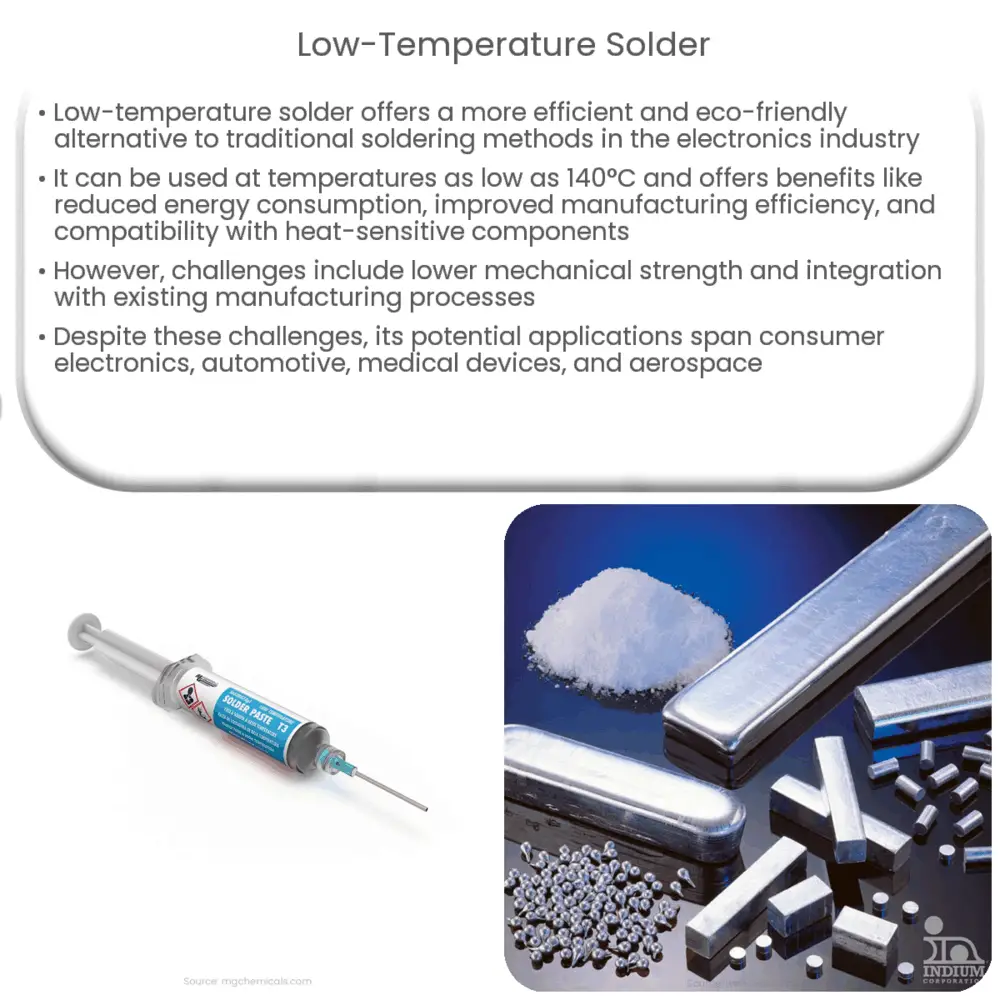Low-temperature solder revolutionizes electronics manufacturing with reduced energy consumption, enhanced efficiency, and compatibility with heat-sensitive components.

Low-Temperature Solder: Revolutionizing the Electronics Industry
Introduction
Low-temperature solder has emerged as a game-changer in the electronics industry, providing an alternative to traditional high-temperature soldering methods. This innovative technology offers a range of benefits, from reduced energy consumption to improved manufacturing efficiency. In this article, we will explore the basics of low-temperature solder, its advantages, and its potential impact on the future of electronics manufacturing.
What is Low-Temperature Solder?
Low-temperature solder refers to soldering alloys with melting points significantly lower than those of conventional lead-based or lead-free solder alloys. Traditional soldering processes typically require temperatures between 180°C and 230°C, whereas low-temperature soldering can be achieved at temperatures as low as 140°C.
Low-temperature solder alloys are often composed of bismuth (Bi), tin (Sn), and other elements such as indium (In) and silver (Ag). These combinations form eutectic or near-eutectic mixtures that provide optimal melting characteristics for soldering applications.
Advantages of Low-Temperature Solder
Low-temperature solder offers several key benefits for electronics manufacturers:
- Reduced energy consumption: By lowering the required soldering temperature, low-temperature solder helps reduce energy consumption in manufacturing processes. This can lead to cost savings and a smaller environmental footprint for electronics manufacturers.
- Improved manufacturing efficiency: Lower soldering temperatures can speed up the assembly process by reducing the time needed for components to cool and solidify. This can lead to increased production rates and improved efficiency in electronics manufacturing.
- Better compatibility with temperature-sensitive components: Traditional high-temperature soldering processes can damage heat-sensitive electronic components, such as plastic connectors or thin film substrates. Low-temperature soldering reduces the risk of thermal damage, allowing for greater flexibility in component selection and design.
- Reduced thermal stress on assemblies: High-temperature soldering can cause significant thermal stress on electronic assemblies, which can lead to warping or deformation of the printed circuit board (PCB). Low-temperature soldering reduces this risk, improving the reliability and durability of electronic devices.
The Future of Low-Temperature Solder
With its numerous advantages, low-temperature solder is poised to revolutionize the electronics industry. As demand for energy-efficient and environmentally friendly manufacturing processes continues to grow, low-temperature solder is expected to gain traction as a viable alternative to traditional soldering methods.
Moreover, the development of new low-temperature solder alloys and advancements in soldering technologies will further enhance the capabilities of this emerging technology. As a result, we can expect to see low-temperature solder play an increasingly important role in the future of electronics manufacturing.
Challenges and Limitations of Low-Temperature Solder
Despite its many advantages, low-temperature solder also presents some challenges and limitations that must be addressed:
- Mechanical strength and reliability: Low-temperature solder alloys generally have lower mechanical strength compared to traditional solder alloys. This can affect the long-term reliability of solder joints, particularly in applications where mechanical stress is a concern. Ongoing research aims to develop low-temperature solder alloys with enhanced mechanical properties to address this issue.
- Compatibility with existing manufacturing processes: Implementing low-temperature solder in existing manufacturing processes may require adjustments to equipment and process parameters. Manufacturers need to carefully evaluate the feasibility and cost of transitioning to low-temperature soldering technologies.
- Cost considerations: Some low-temperature solder alloys, particularly those containing indium or silver, can be more expensive than traditional solder alloys. Manufacturers must weigh the cost benefits of reduced energy consumption and improved efficiency against the increased material costs.
Applications of Low-Temperature Solder
Low-temperature solder has a wide range of potential applications in the electronics industry, including:
- Consumer electronics: The reduced thermal stress and improved compatibility with temperature-sensitive components make low-temperature solder particularly suitable for the assembly of consumer electronic devices, such as smartphones, tablets, and wearable technology.
- Automotive electronics: Low-temperature solder can help address the growing demand for energy-efficient and lightweight electronic components in the automotive industry. Its compatibility with heat-sensitive materials can enable the integration of advanced electronics in various automotive systems.
- Medical devices: The use of low-temperature solder in medical devices can minimize the risk of thermal damage to sensitive components and substrates, ensuring the reliability and performance of life-critical systems.
- Aerospace and defense: Low-temperature soldering processes can improve the assembly of high-reliability electronics used in aerospace and defense applications, where durability and resistance to harsh environments are crucial.
Conclusion
Low-temperature solder has the potential to significantly impact the electronics industry by offering a more energy-efficient, environmentally friendly, and flexible soldering solution. While there are challenges to be addressed, the benefits of low-temperature solder, such as reduced energy consumption, improved manufacturing efficiency, and compatibility with temperature-sensitive components, make it a promising alternative to traditional soldering methods. As research and development efforts continue to advance, low-temperature solder is likely to play an increasingly important role in the future of electronics manufacturing.

